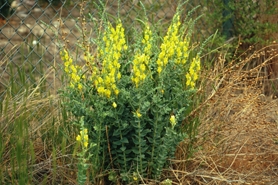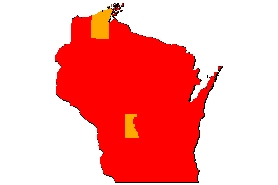Dalmatian toadflax
(Linaria dalmatica)
An herbaceous perennial growing up to 4 feet tall. Plants have waxy heart-shaped leaves. Flowers are yellow with orange markings and distinct spurs.
Other names for this plant include:
- Common names: Balkan toadflax, broadleaf toadflax, wild snapdragon
- Scientific names: Linaria genistifolia ssp. dalmatica, Antirrhinum dalmaticum
Classification in Wisconsin: Prohibited/Restricted (Restricted in Bayfield and Juneau counties; Prohibited elsewhere).
- Ecological Threat
-
- Invades pastures, rangelands, prairies, clear-cut forests, and other open, disturbed areas.
- Spreads rapidly via creeping roots, forming colonies.
- Significantly reduces crop yields in infested areas.
- They are recognized as invasive across much of the United States.
- Plants can produce up to 500,000 seeds annually. Seeds can germinate in both spring and fall.
- Identification
-
Leaves & stems: Heart-shaped leaves are clasping at the stem base. Stems are somewhat woody near the bottom with branching near the top. Stems and leaves are slightly waxy.
Flowers: Yellow flowers are similar to other species in the figwort family (Scrophulariaceae). Flowers have long spurs and often orange markings.
Fruits & seeds: Half-inch long pods enclose black to brown-colored seeds with wings.
Roots: Taps roots can extend 4 - 10 feet deep in the soil. Lateral roots may grow as far as 12 feet from the parent plant.
Similar species: White varieties of dalmation toadflax are sold under wild snapdragons. These are treated as equally invasive. Yellow toadflax or butter and eggs (Linaria vulgaris; non-native) is a similar species with long, narrow leaves.
- Control
- Mechanical:
- Keep plants from going to seed. Hand pulling, mowing, or tilling are effective at controlling seed production. Clean equipment thoroughly to avoid spreading the infestation into new areas; plants are readily applied via root fragments.
- Continual cutting or mowing for multiple years may effectively exhaust root reserves.
- Management is most effective if carried out in mid-summer.
- Chlorsulfuron, dicamba, picloram and imazapic are all reported as effective herbicides to control this species.
- Use an appropriate surfactant for the chemical chosen.
- Monitor for regrowths. Retreatment may be needed for several years.
- Triclopyr and glyphosate are NOT effective herbicides for control.
- Resources
- Sources for content:
- Zouhar, Kris. 2003. Linaria spp. In: Fire Effects Information System, [Online]. U.S. Department of Agriculture, Forest Service, Rocky Mountain Research Station, Fire Sciences Laboratory (Producer).
- University of Colorado- Extension.
- Wisconsin Botanical Information System. Wisconsin State Herbarium. Wisflora- Vascular Plant Species.


